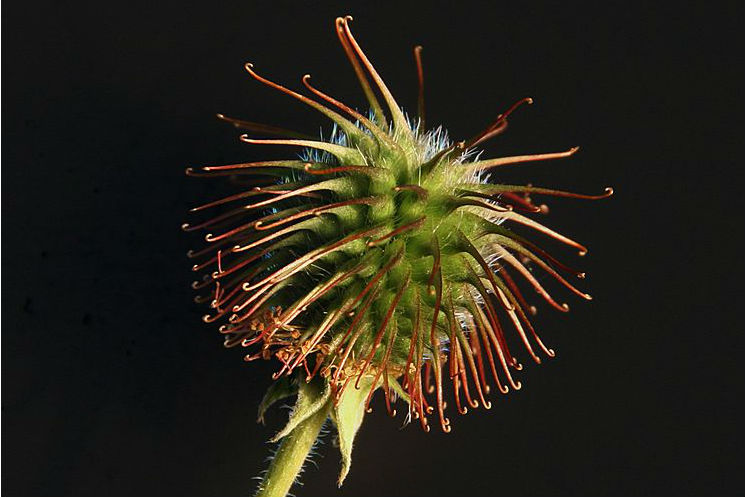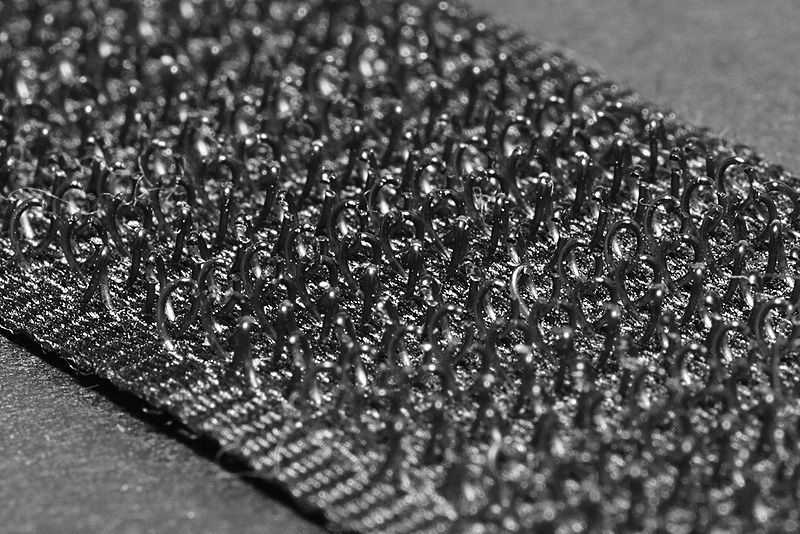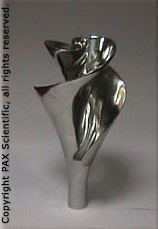You are here
The consultancy Biomimicry 3.8 recommends doing biomimicry as an eight-step process:
1. Define the problem and its context well
2. Identify the function desired, translating into biological terms
3. Integrate life's principles
4. Discover natural models
5. Abstract the biological strategies you found into general principles
6. Brainstorm off of the principles gathered from the mentors
7. Emulate the biological design principles as buildable things.
8. Measure the success of your top ideas, using life's principles, and choose the best buildable idea.
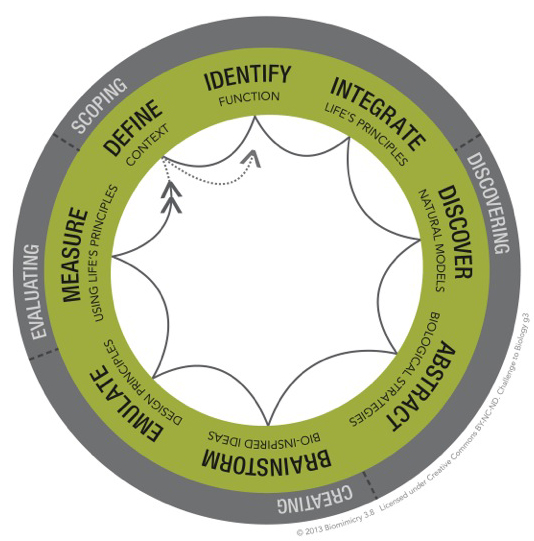
The Steps in Detail
Defining the problem is always an important step in design: if you want to invent the next-generation refrigerator, is your goal to cool food, or to prevent food from spoiling? The two different problems can have very different answers. Context is also important: for instance, what constraints does the next-generation refrigerator have? Will it be used by a low-income individual off-grid in the Sahara, or by a rich distributor warehouse in Singapore?
Identifying the function is largely translation of the problem and its context into a biological metaphor. This gives you starting places of where to look in nature: for the problems above, how do animals keep cool in the desert? How do plants avoid mold in tropical humidity?
Translating the problem and its context into a biological metaphor then gives you starting places of where to look: for the problems above, how do animals keep cool in the desert? How do plants avoid mold in tropical humidity?
Integrating life's principles (see the list of life's principles) can be useful to shortcut and/or to more tightly focus your search in the next step.
Discovering natural mentors is the exciting part. Some can be found just by going for a walk in your neighborhood; others are more obscure, requiring research--online in places such as AskNature.org, in books or academic journals, perhaps even by hiring a biologist for advice. It's best to find many different strategies from quite divergent sources (e.g. plants, animals, microbes, and fungi, or looking at different biomes for different contexts, etc.) This gives you more design alternatives. Also, where you see the same strategy used again and again, it’s often a hint that it is very effective.
For instance, most warm-blooded animals keep cool by sweating, which works by the principle of evaporative cooling. To imitate this and keep your food cool while off-grid in the desert, you could simply cover a pot of food with a damp cloth in a well-ventilated place. This is, in fact, a traditional practice in some places. Or if your problem statement is to avoid mold, instead of cooling food you might find inspiration in the fact that grapes use anti-fungal chemicals. Imitating this chemical, you may find that you can extend the shelf-life of apples by a factor of six at room temperature.
Abstracting the biological strategies you found into general principles of physics, chemistry, relationship, etc. is how you ensure you are not blindly imitating nature (which often fails), but truly understanding what the insights are that can be valuable for your problem-solving.
Brainstorming from the ideas found in nature can further expand your possibilities. You may have new ideas based on the natural strategies, or combine ideas, etc.
Emulating natural strategies as buildable products or systems is a crucial part of the process, and is often the hardest part (it took ten years to commercially manufacture Velcro). Thus, it is important to do this before choosing your best strategy. Nature's best strategy may not be buildable with our technology today. Here again outside experts could help, though instead of biologists, it may be physicists, organic chemists, or other experts you need to understand the principles at work. Engineers doing long-term research and development may have the luxury of developing new materials or chemicals to imitate nature precisely, but most architect, designers, and engineers are tasked with building a workable thing today.
In the previous examples, it is obviously much easier to drape a damp cloth over a pot than to understand and copy the antifungal chemistry of grapes. You may need to settle for imitating part of the strategy you found, or abstracting it more metaphorically until you find a buildable idea. Remember, good biomimicry is inspiration from nature, not slavish imitation of it.
Velcro imitates burr hooks on one side, fur on the other. (Wikimedia Commons1,2)
Measuring to choose the best buildable design is the final step. Narrowing down the ideas is similar to the process used after any ideation session. You must check your new ideas against the initial problem statement. Your explorations may have found things that cause you to redefine your problem statement, in which case you can do the entire process over again.
The unique part of this step is measuring the success of your designs not only by your criteria, but by nature's criteria as well. Velcro performs its job of adhesion admirably, but how does its life-cycle compare to burrs and fur? At the end of its life, does it become food for other products or natural organisms? Can it be manufactured as simply as throwing a seed in dirt and adding water? Questions like these never appear in traditional design, but can give insightful perspectives on sustainability.
Examples
There are examples of biomimicry for sustainable design in many industries, from buildings to transportation to consumer products. An AskNature search will turn up hundreds. Here are just a few:
Lotusan Paint imitates the micro-structure of the lotus leaf to keep itself clean. Rainwater washes right off immediately, carrying dirt away with it and helping avoid mold and mildew. This allows building owners to nearly eliminate their use of chemical soaps and bleaches to clean exterior walls.
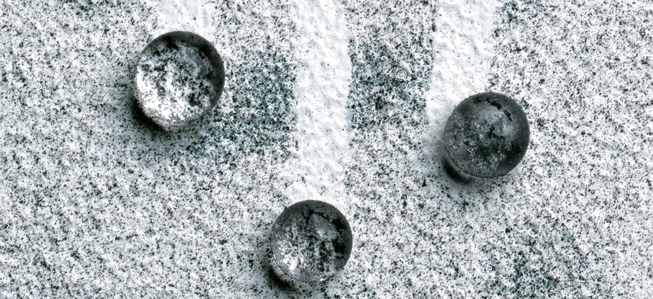
Lotusan paint imitates a lotus leaf's surface texture
to make water carry away dirt. (from Ask Nature, photo: Sto Corp., Atlanta, GA)
The Eastgate office building and shopping center in Harare, Zimbabwe imitates the ventilation tunnels in a termite mound to provide passive cooling for its occupants. The system uses 90% less energy for air conditioning, is still comfortable if power outages occur, and even saved $3 million in construction costs because almost no air conditioning equipment was required.
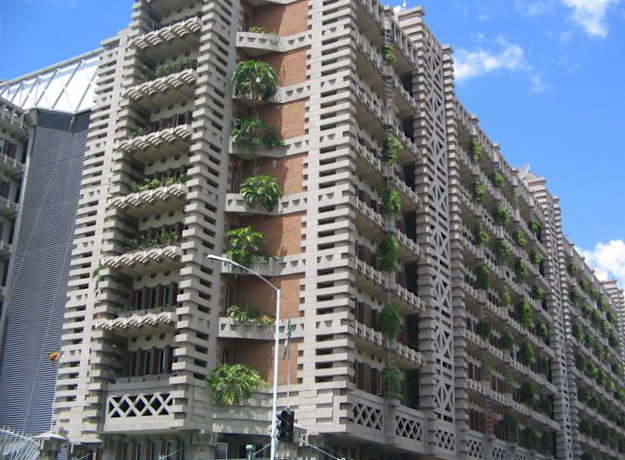
The Eastgate building in Harare, Zimbabwe
imitates a termite mound's passive ventilation. (From AskNature, photo: Mandy Patter)
Japan's Shinkansen 500 series bullet train has a nose that imitates the beak of a kingfisher bird, in order to reduce noise from the air pressure waves caused when the train passes through tunnels. It also reduces noise by imitating the shape of owl feathers in the structure it uses to pull electricity from overhead wires. Besides these design elements reducing noise, they also improved the train's efficiency, allowing it to use 15% less energy while traveling 10% faster.
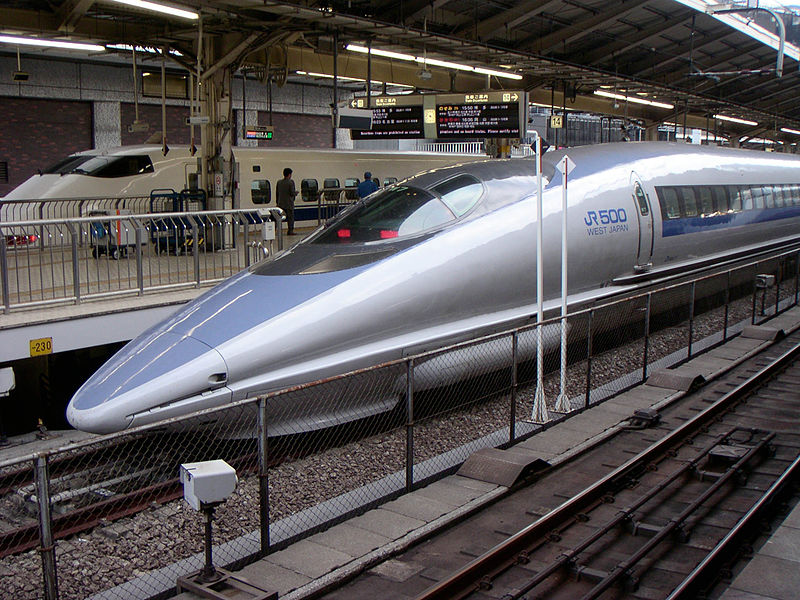
The 500 series Shinkansen train imitates a kingfisher beak's form
to smoothly cut through changing air pressure. (Image from Wikimedia Commons)
Pax Water impeller blades imitate the spiral path of ocean water currents and many sea shells. Their Lily Impeller uses 85% less energy than a comparable water mixing impeller, with far less noise as well. Rather than creating chaotic turbulence in water as it spins, its shape sets up vortex structures in the water flows to multiply its effectiveness.
The Lily Impeller creates spiral water flows like ocean currents to mix liquids efficiently and with low noise.

